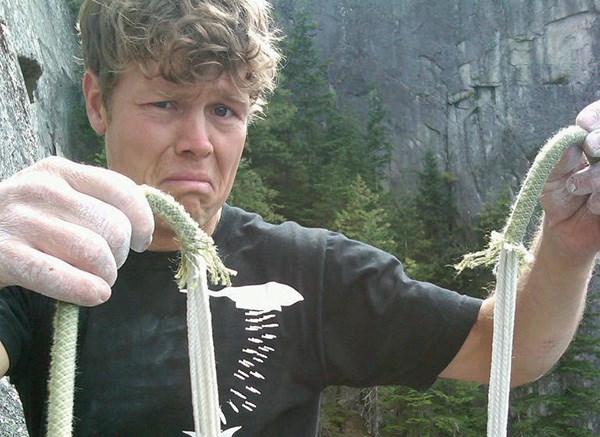The rope. This week is a simple one, but one that is at the root of all the misunderstanding levelled at climbers by the general public. You know the comments: “You have a death wish,” “You’re an adrenaline junkie,” “You think you have nothing better to live for,” “You’re so selfish, you’re crazy,” and my personal favourite, “Daredevil.”
Thanks to Petzl, Wikipedia and Casandra Marie Bright’s thesis research for the faculty of mechanical engineering at the University of Arkansas, we know that the climbing rope, or, more accurately, dynamic rope, is a relatively simple piece of gear that came about in 1953 when the German company Edelrid manufactured the first Kernmantle rope. Until 1945, climbing ropes had been made of natural plant and animal fibers such as hemp or sinew. Climbers switched to synthetics like nylon after the First World War and after DuPont patented its fiber in 1935. North America saw the first nylon climbing lines in the early 1940s. The main difference to the 1953 kernmantle rope was that they provided no or low stretch. This was a big deal to a climber who might fall off. Much of the force in a fall would be transmitted to the climber, very likely causing severe injury or worse. In the dynamic Kernmantle rope, Kern being German for core and Mantel for jacket, a core of nylon strands gives the strength and the nylon mantle or coat, the abrasion protection. With new nylon fibers that gave the ropes stretch, a climber effectively had a shock absorber tied to them that could dissipate much of the force in a fall. The core of the rope accounts for around 80 per cent of its strength while the sheath gives protection as the rope slides across the rock surface. Common rope diameters for dynamic ropes used by climbers are nine milimetres on the low end and up to 11 milimetres on the thick side. It follows that skinnier ropes stretch more, abrade faster and wear out quicker while the thicker cords stretch less, have more surface area to deal with abrasion better and have a longer life, all things considered.
Climbers today enjoy lighter and better handling, more supple ropes that deal better, and absorb less water and handle abrasion better than their original counterparts. The lightest, skinniest single dynamic ropes on the market today weigh in at below nine milimetres in diameter, which would make you think that failures would be happening. Incredibly, according to Casandra Marie Bright, no dynamic rope of nine to 11 milimetres has ever failed due to the falling climber, even including the 1960s when ropes only routinely held two test drops before complete failure. Almost as a blanket statement, ropes fail over edges or are cut due to falling rock. Ropes may fail due to user error or improper use, but they have never simply broken. Given how old nylon dynamic rope technology is and its success rate for safety, it’s uniquely impressive that while ropes have lightened up, changed material properties slightly, improved weave patterns, become less water absorbent and can absorb more force, they really haven’t changed much at their essence since inception. That’s a rare piece of invention today that can boast such little improvement over the main idea over time.
What’s on the horizon of rope technology to help keep more climbers safer while doing what they love? One new idea gathering steam is the Unicore technology championed by Beal, a French rope manufacturer. Here they bond the rope fiber bundles with the overlaying nylon sheath to create a more connected whole. It still has two parts that do the same roles but they don’t move separately of one and other. This is a game changer when it comes to cutting your rope’s sheath, exposing its core, potentially damaging those all while the sheath slides and pulls away from the damaged sight like a snake sluffing off its dry and dead old skin. With the Unicore ropes, they stay connected, sheath supporting core and core supporting sheath. But what else? Some Visionaries have suggested nano tech materials which could be layered or combined to create super strong abrasion resistant wholes or materials with different rates of stretch depending on where your protection was on a pitch and where hazards were on the route, all monitored by sensors embedded within the nano-technology matrix of interlayered hollow fibers?
Would you rather your life hang from a blend of simple and understandable technologies and processes or from a blended matrix of cutting edge scientific thought?




